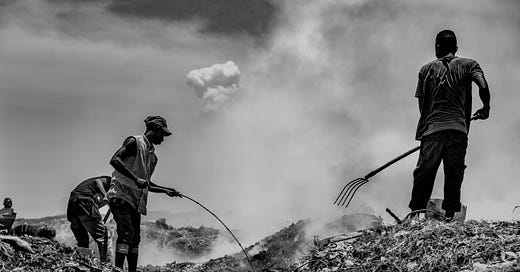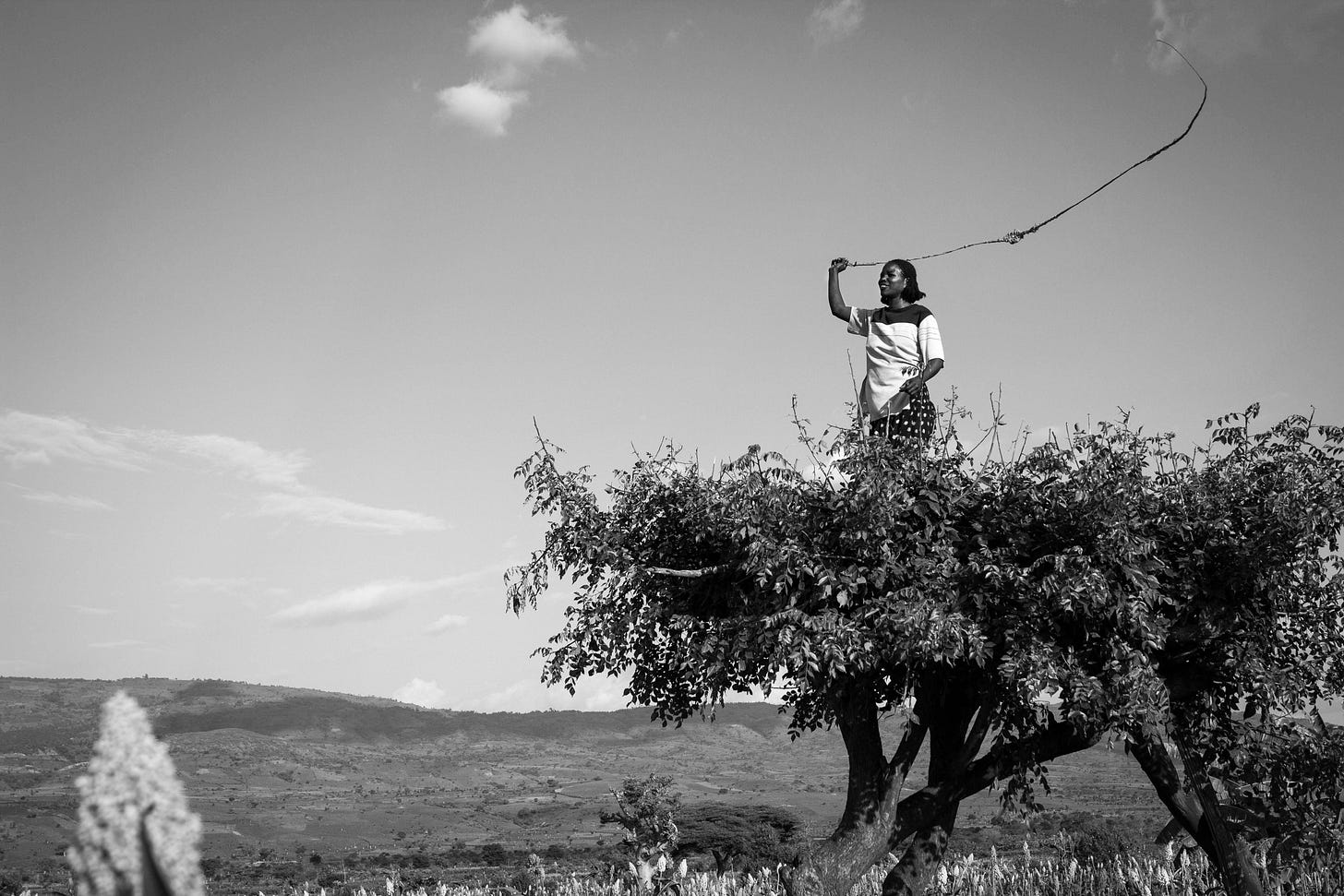If read from left to right, the photograph seems to show the progression of an activity, and each man represents a stage in its unfolding. Irrespective of their position, their feet hide behind piles of debris. At the right side of the frame, a cluster of smoke connects earth and sky.
— Zenas Ubere
“My works take various forms intended to attract the viewer as a witness.”
I have been working for a while on a philanthropic photography project with a group of women who live off the largest landfill in the city of Bujumbura. I came across these young scrap metal hunters looking in this same dump that day. My interest in them came suddenly, and that’s how I made this trip with them through these photos. They allowed me to follow them to the sites where they hunt their loot. I was amazed at the technique they used to find their treasure. They burn the trash so that all the debris becomes visible. Then they pour water on it to put out the flames and release the smoke. In order, they recover the loot by walking on the charred debris, wearing simple slippers or worn shoes.
I chose this photograph because it corresponds to the values that I embody, or rather, that I try to embody. My works carry a more or less positive vision despite social, political and cultural adversity. They highlight the beauty, the bravery, the innocence of the people of the world. Often referring to a sort of “success story”, my work explores the different relationships between culture, way of life and beauty in originality. My goal is not to dishonor the people I photograph by painting them as underprivileged or beggars. Rather, I glorify their “meager” effort to meet their basic needs while maintaining their dignity. Always working in the narration of the stories of people, of nature – in short, of living beings – my work reproduces familiar visual and auditory signs, playing the role of a catalyst of global awareness of the social and environmental emergency.
My works take various forms intended to attract the viewer as a witness, offering an experiential chance to question one’s perception, perspective and assumptions about the other. The subject of each work determines the way of proceeding and the form, and the result depends on a good understanding of the subject. Each project often consists of several works, often in a range of different media, grouped around specific themes and meanings. During research and production, new areas of interest emerge and lead to the next body of work. In short, a subject never ends because there is always something to add, something to tweak, etc. The important thing is to get the message across.
— Fabrice Mbonankira
About Fabrice Mbonankira
Fabrice Mbonankira (b. 1989) is a Burundian photographer based in Bujumbura. Recipient of the Seed Awards (2022) and winner of the East African Photo Awards 2023, he has exhibited in Buenos Aires (Argentina) 2022, Alliance Française of Ibadan (Nigeria) 2023, the UPPA 2023 winners in Kampala (Uganda), and Addis Ababa (Ethiopia) for the winners of the Andrei Stenin 2023 contest. See more of his work here and here.
LAST WEEK — “An Ode to Women in Rural Ethiopia” by Hilina Abebe
In this image Koite shoos away birds from her Sorghum field in Derashe, Southern Ethiopia. I met her in 2014 on an assignment focusing on access to clean drinking water. At 25 she was already a mother of three and fully managed her household and the farm. She graciously spent her afternoon with me discussing her daily chores, which involved collecting water from the river more than an hour away. She then showed me her sorghum field and climbed a tree to demonstrate how she kept the birds away.
This is the 109th edition of this publication, edited by Zenas Ubere, one of our editorial fellows. The newsletter also read on web (best for viewing images), and via the Substack iOS/Android apps.
TENDER PHOTO is a newsletter on African photography. Every Wednesday we feature a photograph and a short caption about it, and include a statement from the photographer. Last year, we published commentaries or photo-essays in response to photographs previously featured on the newsletter, including CORRESPONDENCES, CONCORDANCE, KINDRED, and INDEX. The ongoing series, AFFINITIES, will run from March 1–April 26.
Our goal is to work with African photographers by creating a platform in which they lead the cataloguing and engagement with their work.
Thank you for reading. If this newsletter was shared with you, consider subscribing, or forward to a friend. Please whitelist the newsletter to ensure you never miss it.






